New AMD CPU/GPU rivals Intel Atom
Last updated Jan 18, 2011 — 7441 views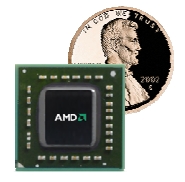 AMD’s long-anticipated competitor to Intel’s popular Atom processor line has quietly begun shipping to device makers. AMD’s initial Embedded G-Series processor consumes less than 9W of power and crams dual 64-bit x86 CPU cores, an ATI Radeon GPU (graphics processing unit), system and DRAM controllers, PCI Express, and HD video interfaces into a single piece of silicon in a package that occupies about half a square inch of board space. Is this the rumored “Atom killer”?
AMD’s long-anticipated competitor to Intel’s popular Atom processor line has quietly begun shipping to device makers. AMD’s initial Embedded G-Series processor consumes less than 9W of power and crams dual 64-bit x86 CPU cores, an ATI Radeon GPU (graphics processing unit), system and DRAM controllers, PCI Express, and HD video interfaces into a single piece of silicon in a package that occupies about half a square inch of board space. Is this the rumored “Atom killer”?
AMD cites analyst data sizing the embedded processor market at $3 billion annually in 2010, and predicting it to grow at double-digit rates for at least each of the next five years. It’s aiming the new Embedded G-Series processors at “graphics-intensive solutions like digital signage, internet-ready set top boxes, mobile and desktop thin clients, casino gaming machines, point-of-sale kiosks, and small form factor PCs, as well as numerous single board computers (SBCs).”
AMD’s new math: CPU + GPU = “APU”
Ever since AMD’s 2006 acquisition of video chipmaker ATI, the company has said it planned to “create a new class of x86 processor that integrates the central processing unit (CPU) and graphics processing unit (GPU) at the silicon level with a broad set of design initiatives collectively codenamed Fusion.”
In June of 2010, the company gave the first public demonstration of its combined CPU/GPU technology. By then, AMD had coined the term “Accelerated Processing Unit” (APU) to signify the “combination of general-purpose x86 CPU cores with [GPU-based] programmable vector processing engines on a single silicon die.”
AMD has published an 8-page whitepaper (pdf download), which describes the potential advantages APUs over traditional CPUs, based on their ability to combine traditional CPU functions with the co-processing capabilities provided from on-chip GPUs.
Quoting from the whitepaper’s conclusion…
“The expectation is that their compatibility with Windows 7 and DirectX 11 will ensure that they will provide an outstanding experience for those who purchase PCs based on these processors. Their enhanced processing power and power efficiency will enable sharp and clear videos, realistic and responsive games, and notebooks that can run longer between battery charges.”
“More importantly, compared to today’s mainstream offerings, APU-based platforms will possess prodigious amounts of computational horsepower. This processing power will allow developers to tackle problems that lie beyond the capabilities of today’s mainstream systems, and will enable innovative developers to step up and update existing applications or invent new ones that take advantage of GPU acceleration. These features will be a standard part of every APU. Over time, even the most affordable PCs can be expected to have the computational performance of yesterday’s million dollar mainframes with ‘all day’ battery life.”
G-Series Platform architecture
AMD’s inaugural Embedded G-Series platform chipset (codename “eBrazos”) is implemented in the form of a pair of low-power, ball-grid-array components — an APU and an I/O Controller Hub:
- Application Processing Unit (APU) — integrates a low-power x86 dual-core CPU (codenamed Bobcat; see diagram, below-left) along with a full-fledged GPU and parallel processing engine; the APU includes video interfaces, four PCIe lanes, and a DDR3 DRAM interface (see diagram, below-right).
- Fusion I/O Controller Hub — the G Series platform’s Fusion I/O Controller Hubs (two pin-compatible models initially are available) conveniently add four more PCIe lanes, SATA, LPC (low pin count) bus, SPI (serial peripheral interface), CIR (consumer IR), HD audio, and a Gigabit Ethernet MAC
The block diagrams below show the partitioning of functions between the two Embedded G-Series platform components (click each image to view a larger version).
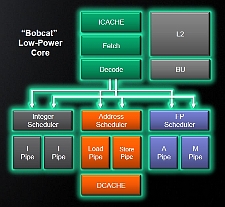

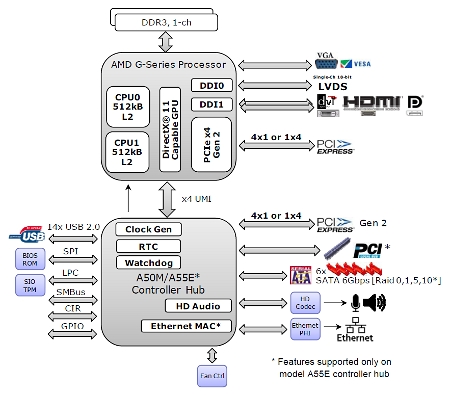
Embedded G-Series block diagrams
(click each image to enlarge)
Features & specs
The key features of the Embedded G-Series APU, as listed by AMD, are…
- 1 or 2 x86 “Bobcat” CPU cores with 1MB L2 cache, 64-bit Floating Point Unit
- Up to 1.6GHz CPU clock rate
- 9W or 18W TDP (thermal design power)
- Array of SIMD (single instruction multiple data) engines
- DirectX 11 capable graphics
- Industry-leading 3D and graphics processing
- 3rd Generation Unified Video Decoder
- Various power management features, including C6 and power gating
- Supports DDR3 800-1066 memory, including 64-bit channel and 2 DIMMs
- Contained within a single piece of silicon in a 361 sq-mm, 413-ball BGA package
The platform’s I/O Controller Hub currently comes in two versions: the basic A50M and the higher-end A55E. We’ve assembled a much more detailed list of the Embedded G-Series platform’s features and specs in this detailed list. Additionally, you may want to read the complete G-Series product brief, which is available here (pdf download).
Comparing the Embedded G-Series platform to Intel’s Atom and Core i5 platforms
AMD has provided a pair of illustrations that compare the footprint and power consumption of its new Embedded G-Series platform to Intel’s Atom 400/500/600 and Core i5 platforms. The functional partitioning of Intel’s Atom and Core i5 platforms are shown in the three block diagrams below.
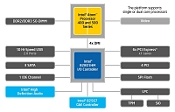

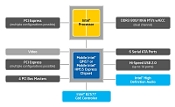
Intel Atom 400/500, Atom 600, and Core i5 platforms
(click each image to enlarge)
AMD’s analysis appears in the two slides below. The one on the left compares the Embedded G-Series to Intel’s Atom processors and associated I/O controller hubs, while the slide on the right stacks it up against Intel’s Core i5 520M processor and associated I/O hub.
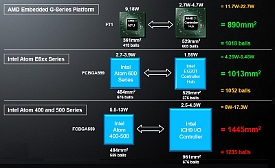
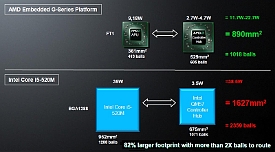
AMD G-Series compared to Intel Atom and Core i5 520M
(source: AMD; click each image to enlarge)
As seen above, AMD’s two-chip platform is about 12 percent smaller than Intel’s Atom 6xx platform, but uses 3-4 times the power. Intel’s Atom 4xx/5xx platforms, on the other hand, are substantially larger in footprint and have power consumption closer to that of the AMD Embedded G-Series platform.
It’s not so clear why AMD chose to compare its Embedded G-Series to Intel’s Core i5 520M, however. The latter occupies nearly twice the board space, consumes 2-3 times the power, and most likely delivers 2-3 times the performance of AMD’s platform. Perhaps it’s a target for a future Embedded G-Series release.
Embedded G-Series vs. Atom benchmark data
In DeviceGuru’s benchmark tests using an AMD-provided evaluation system (pictured below), the Embedded G-Series platform deftly handled typical multimedia and storage tasks under both Ubuntu 10.10 and Windows 7, including 1080p HDMI output to a Sony HDTV. The system is based on a Mini-ITX form-factor SBC, manufactured for AMD by iBase.
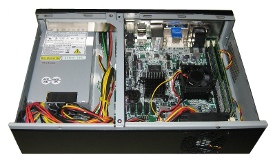


AMD’s G-Series Evaluation platform packs a 2.5-inch HDD
(click each image to enlarge)
It’s interesting to compare the Embedded G-Series Mini-ITX board to a typical commercial Atom-based Mini-ITX SBC. The two are shown below; in comparing them, bear in mind that AMD’s was designed for evaluation purposes only, so its selection of I/O ports leaves much to be desired for actual real-world applications.
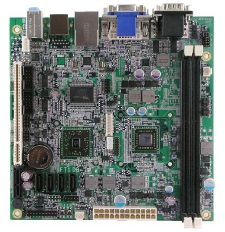
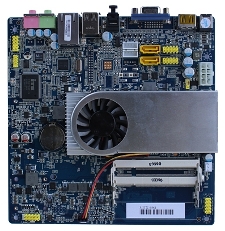
Two Mini-ITX SBCs: Embedded G-Series (left); Atom 5xx (right)
(click each image to enlarge)
The Atom board (above, right) is Habey’s 6564 Mini-ITX SBC. It’s based on Intel’s 1.8GHz dual-core, 64-bit Atom D525 processor, combined with Nvidia’s “next generation ION” graphics controller.
The charts below show PassMark benchmark data for these two Mini-ITX boards. Note, though, that it’s not an apples-to-apples comparison, since AMD’s APU-based evaluation system had 1.0GHz CPU clock rate and 4GB of DRAM, while Habey’s Atom box has a 1.8GHz CPU clock rate and 2GB of DRAM. In general, the Atom 5xx platform was faster but used more power, as would be expected.
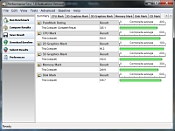
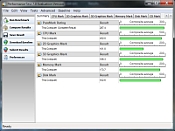
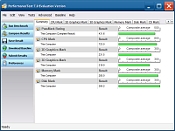
Left to right: benchmark data summary for 1GHz G-Series 64-bit test; 1GHz G-Series 32-bit test; 1.8GHz Atom D518 32-bit test
(click each image to enlarge)
Additional benchmark data follows, organized in three in groups by processor (AMD or Intel) and 32- or 64-bit testing, as labeled:






1GHz G-series (64-bit PassMark test results)
(click each thumbnail to enlarge)






1GHz G-series (32-bit PassMark test results)
(click each thumbnail to enlarge)






1.8GHz Intel Atom D525 (32-bit PassMark test results)
(click each thumbnail to enlarge)
A power miser
One subjective observation we made during our evaluation of AMD’s Embedded G-Series platform, was the utter absence of heat and fan noise — despite the system running Windows 7, streaming videos, madly copying files, or undergoing intensive benchmark tests. The APU-attached fan did spin up for a few seconds while the BIOS initialized the system, but as soon as the OS took over, the CPU fan fell silent and stayed that way; and the system’s enclosure remained cool to the touch.
On a more objective level, here’s a summary of DeviceGuru’s power measurements of the Embedded G-Series development system running Windows 7 (including the hard drive’s power consumption):
- In sleep state – sub-1W
- At idle Windows 7 desktop – 12W
- Copying a large batch of files around on the HDD – 15W
- Streaming and playing video from the web via Flash or Silverlight – 17-18W
For comparison, Habey’s 1.8GHz Atom-based system running Windows Embedded Standard measured 19W at idle desktop; 21W while copying files around on the HDD; and 26W while streaming video from the web via Firefox/Flash. Assuming power scales roughly in proportion to CPU clock rate, 19W idle desktop power isn’t bad for a complete 1.8GHz processor-based system (including its hard drive).
If you’re embedding an x86 processor into an Internet-enabled set-top-box, HDTV, or other consumer gadget, you’re going to want the best multimedia performance possible within the constraint of not producing any audible fan noise. In this regard, AMD’s Embedded G-Series looks like a winner!
Pricing and availability
AMD’s Embedded G-Series APUs initially will be available in five spins, which primarily vary by number of cores (1 or 2) and processor clock rate (1.0 to 1.6 GHz), as listed in the table below.
| Model | CPU speed | CPU cores | Radeon GPU version | DRAM type & speed | Max TDP |
| T56N | 1.6GHz | 2 | HD 6310 | DDR3-1066 | 18W |
| T48N | 1.4GHz | 2 | HD 6310 | DDR3-1066 | 18W |
| T40N | 1.0GHz | 2 | HD 6250 | LVDDR3-10662 | 9W |
| T52R | 1.5GHz | 1 | HD 6310 | DDR3-1066 | 18W |
| T44R | 1.2GHz | 1 | HD 6250 | LVDDR3-10662 | 9W |
One feature left unmentioned, at this point, is operating temperature range. Given the harsh environments seen by many mobile and embedded applications, we asked what extended operating temperature ranges would be supported by the Embedded G-Series parts. “At this time we do not offer the AMD Embedded G-Series platform with specification for extended temperature ranges,” responded AMD’s spokesperson. “However, we recognize that is a requirement for some vertical markets and we are looking closely at that requirement. Stay tuned to hear more from us on that specification in the future.”
The company declined to state OEM pricing for the Embedded G-Series chips. However, AMD’s spokesperson said the company would “remain as competitive in [the embedded] space as we do in the mainstream consumer and commercial businesses. We understand overall value is critical to our customers and part of that is component pricing, but it is also things like reducing board footprint and layers, and faster time to market.”
The chips are said to be immediately available. “We have been shipping production parts to customers for a few weeks now,” added the spokesperson.
An Atom killer?
So what’s the verdict on how AMD’s Embedded G-Series APUs stack up against Intel’s Atoms?
Here are three thoughts on the matter:
- The low-end APU DeviceGuru tested ran Windows 7 capably, and performed multimedia and storage-oriented tasks adeptly enough to be well suited to graphics-intensive consumer gadgets; if priced aggressively, it should do well in many of the market segments AMD says it’s targeting with the new line of embedded APUs.
- AMD’s APUs could gain a significant advantage over Intel’s Atoms if their integrated GPU-based coprocessing capabilities can be sufficiently leveraged — for example, for encode/decode or encryption/decryption functions — but this will require a strong software focus on AMD’s part, plus attention to key third-party relationships with streaming media sources, such as Netflix, Amazon, and Vudu, and with software vendors, such as Microsoft, Adobe, and Oracle.
- Never underestimate Intel; when they see an advantage in someone else’s technology, they move aggressively to squash it, acquire it, or beat it with their own innovations.
In any case, AMD’s new embedded APUs will help the company compete head-to-head with Atom in the rapidly growing consumer devices market. It’s easy to foresee them being designed into set-top-boxes, Internet-enabled media-streaming TVs, tablets, thin client systems, medical devices, in-vehicle infotainment systems, and many other specialized systems with graphical, multimedia, computational requirements.
In short: Atom Killer? Nope! Cool chip? Yes, literally! Likely to succeed in the market? Absolutely!
For further information on AMD’s new Embedded G-Series family visit the company’s Embedded G-Series Platform page, here.